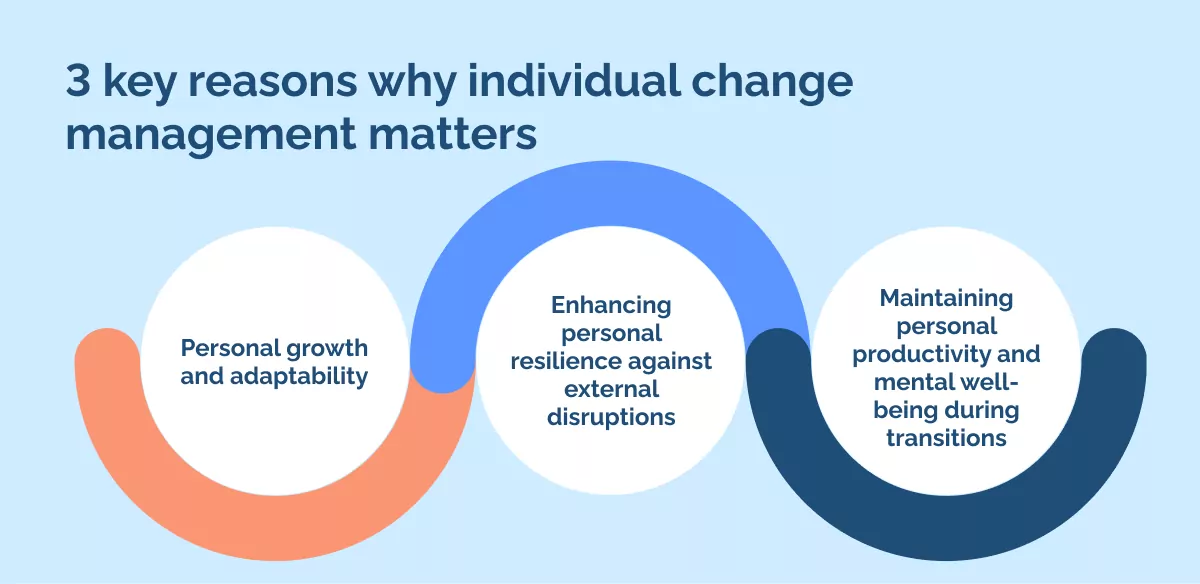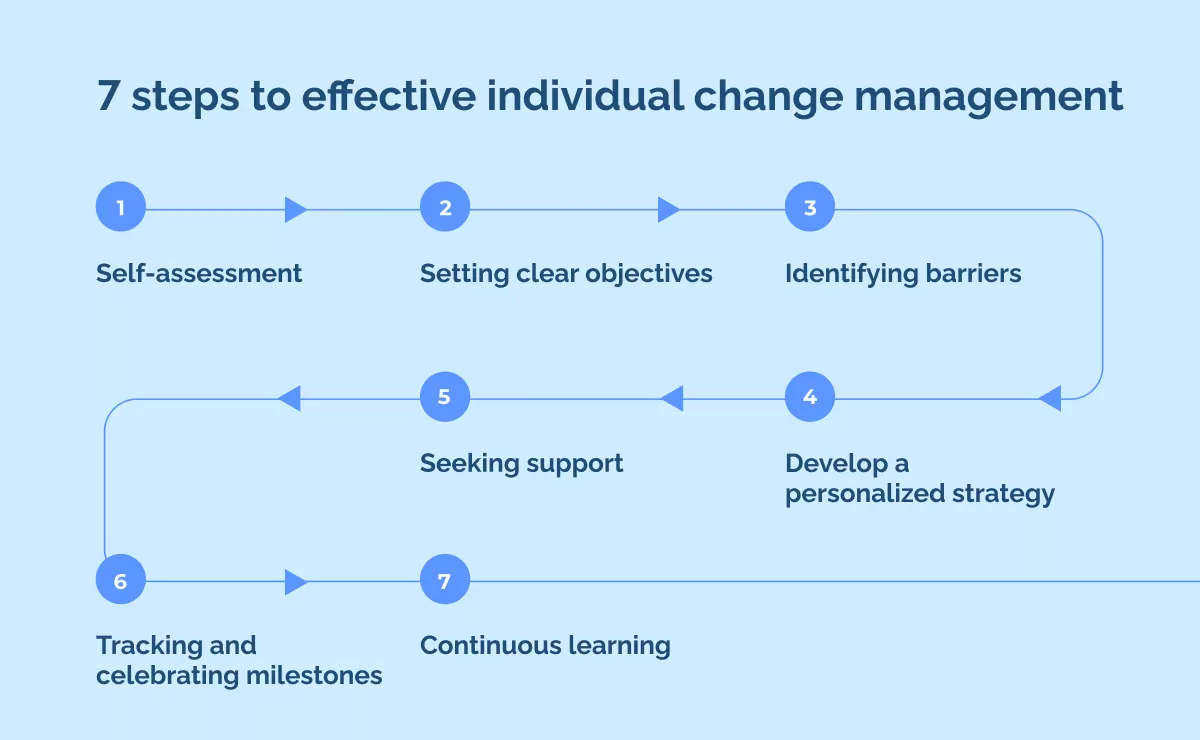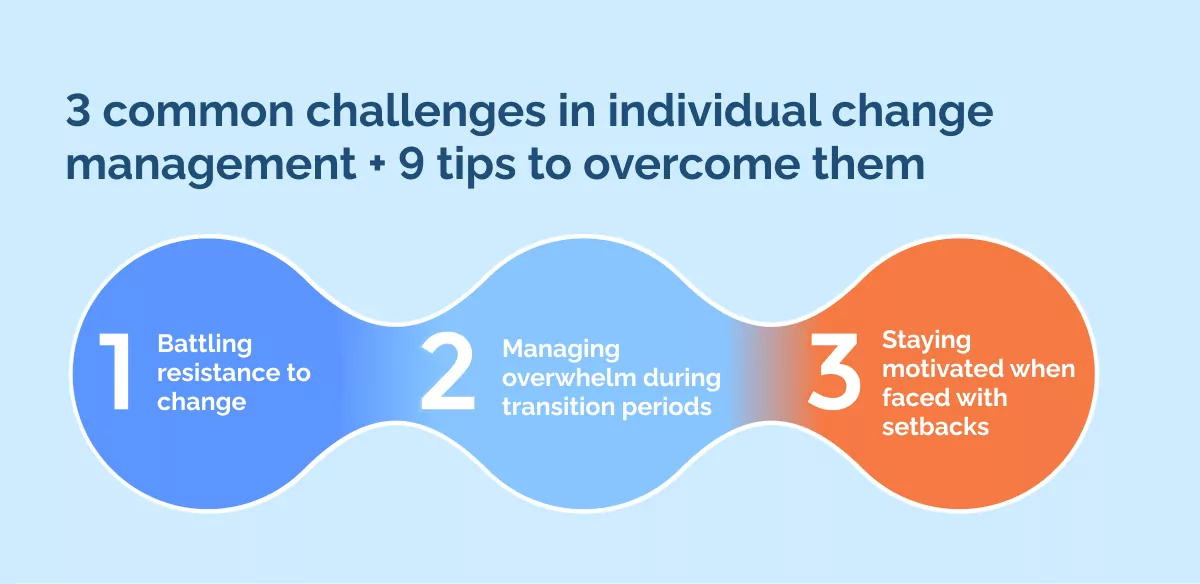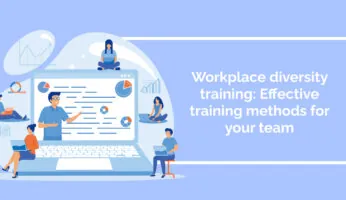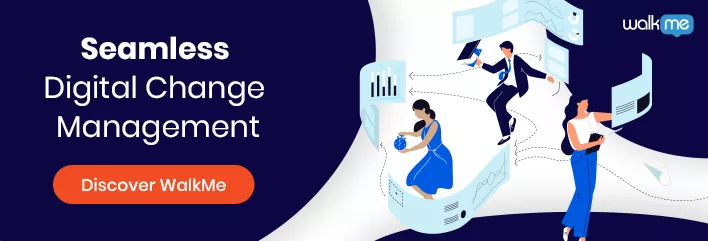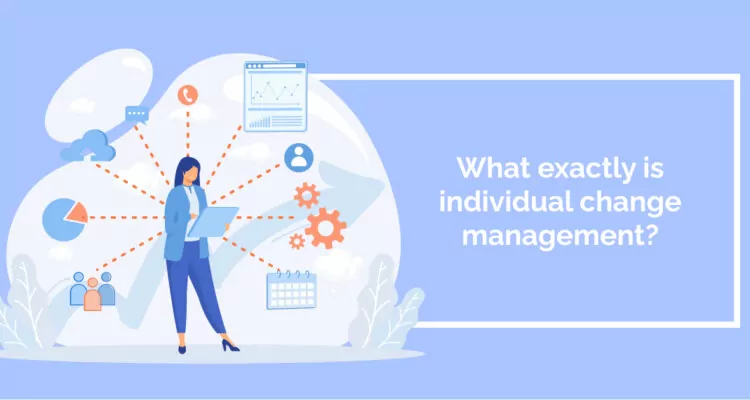
Individual change management refers to the process by which you, as an individual, understand, adjust to, and thrive in an environment of constant change.
Mastering this skill isn’t just beneficial— it’s essential if you want to navigate today’s rapidly changing business landscape.
A report from Prophet found that 51% of digital transformation efforts are fueled by market pressure and growth opportunities.
Furthermore, Spiceworks’ State of IT 2024 found that 76% of businesses plan on long-term IT changes as a result of COVID-19.
All this shows that there’s always something driving change— whether it be market shifts, current affairs, or industry innovation. And you need to be ready for it.
By honing your ability to manage personal change, you position yourself at the forefront of industry developments, ensuring you don’t just cope but actively excel.
In this article, we’re exploring every facet of individual change management. We’re covering everything, including what it is, why it matters, and the steps you can take to master individual change management.
Whether you’re an independent worker or a leader looking to share this information with your teams, by the time you’re done reading, you’ll know how to account for your resilience to change.
The difference between organizational and individual change management
Organizational change management focuses on the strategies and processes companies employ to ensure smooth transitions during periods of change.
This could be mergers, shifts in corporate strategy, technology adoption, or any other large-scale transformation.
The goal here is to reduce resistance, maintain or boost morale, and ensure business continuity.
On the other hand, individual change management is about how you adapt to changes personally. It’s about your ability to recognize the need for change, your resilience in the face of disruptions, and your agility in adjusting your strategies and mindset.
While organizational change aims to align teams and structures, individual change depends on personal growth and adaptability.
Both are vital.
Without a successful individual change management approach, you might struggle to keep pace, potentially jeopardizing your leadership effectiveness.
In a business environment where agility and resilience are prized, it’s paramount that you understand and champion individual change management.
3 key reasons why individual change management matters
In the dynamic world of business, the only constant is change.
It follows that managing change as an individual is a critical skill.
Here are 3 key reasons why individual change management should matter to you:
1. Personal growth and adaptability
To lead, you must be ready to evolve.
The business terrain constantly shifts, with new technologies, market demands, and global events reshaping the landscape.
By embracing individual change management, you ensure you’re not left behind. It paves the way for continuous learning, helping you stay informed and adaptable, ready to harness the opportunities that come with change rather than being sidelined.
2. Enhancing personal resilience against external disruptions
Disruptions, both big and small, are inevitable.
The unexpected can throw a wrench in the best-laid plans, from global pandemics to industry innovations.
However, with a strong foundation in individual change management, you cultivate a resilience that allows you to navigate these disruptions. Instead of being a victim of circumstances, you become a proactive leader, turning challenges into avenues for growth.
3. Maintaining personal productivity and mental well-being during transitions
Change can be stressful.
Whether organizational shifts or personal career moves, transitions can weigh heavily on your mental well-being.
Investing in individual change management equips you with the tools to maintain productivity and mental balance during these times. This ensures you’re operating at your best and sets a positive example for those you lead.
3 key principles of individual change management
To harness individual change management’s power, you must grasp its foundational principles.
Incorporating these principles into your approach to change ensures you’re not just navigating the waves but skillfully surfing them, ready to harness their power for your personal and professional growth.
The 3 key principles of individual change management are:
1. Acknowledging and understanding the need for change
Before you can adapt, you need to recognize the areas demanding change.
Whether it’s a shift in the market, a new technological advancement, or feedback from colleagues, acknowledging these signals is your first step.
By understanding these changes’ root causes and implications, you position yourself to respond strategically rather than reactively.
2. Embracing change as a continuous process
Change isn’t a checkbox you tick off once done. In the ever-evolving world of business, change is ongoing.
Internalizing this creates a mindset that is always ready to adapt, learn, and grow.
This perpetual readiness allows you to seize opportunities swiftly and navigate challenges with agility.
3. The role of self-awareness and reflection in change management
To be an effective leader during times of change, you must also turn your gaze inward.
Regular self-reflection enables you to identify personal strengths, areas for growth, and any biases or blind spots that might impede your adaptability.
By cultivating self-awareness, you ensure you’re evolving in line with external shifts and growing in ways that align with your values and leadership goals.
7 steps to effective individual change management
If you’re intent on mastering individual change management, a structured approach can make your journey smoother and more effective.
By following these 7 steps to effective individual change management, you ensure that your approach to individual change management is both strategic and holistic, setting you up for success in the dynamic business environment:
Step 1: Self-assessment
Begin by taking stock of where you currently stand and where you aspire to be.
What skills, knowledge, or attitudes do you currently possess? Which areas demand enhancement or change?
You create a clear picture of the journey ahead by evaluating your present state and juxtaposing it against your desired future state.
Step 2: Setting clear objectives
With an understanding of your starting point, outline what success looks like post-change.
Do you want to acquire a new skill, adapt to a technological change, or shift your leadership style?
Setting clear, measurable goals will serve as your North Star, guiding your change efforts.
Step 3: Identifying barriers
Every change journey has its hurdles.
By anticipating potential challenges—be it time constraints, lack of resources, or deep-seated habits—you prepare yourself to tackle them head-on.
Forewarned is forearmed.
Step 4: Develop a personalized strategy
With goals set and obstacles mapped, craft a tailored action plan.
How will you bridge the gap between your current and desired state?
This could involve dedicated training, self-study, or seeking external expertise. Your strategy should resonate with your unique needs and pace.
Step 5: Seeking support
No leader navigates change in isolation.
Surround yourself with mentors, peers, and resources offering guidance, a fresh perspective, or even just a listening ear.
This support network will prove invaluable, especially during the challenging phases of your change journey.
Step 6: Tracking and celebrating milestones
Change can be a long game.
To maintain momentum and motivation, break down your journey into smaller milestones.
Each time you achieve one, take a moment to acknowledge and celebrate it. These moments of recognition will fuel your drive.
Step 7: Continuous learning
The business landscape is ever-evolving, and so should you be.
Once you’ve achieved your immediate change objectives, the journey doesn’t end. Stay curious. Keep yourself updated with industry shifts and leadership trends— and be always open to feedback.
This commitment to perpetual growth ensures you remain at the forefront of your industry.
3 common challenges in individual change management + 9 tips to overcome them
Even the most seasoned business leaders will find individual change management challenging from time to time.
Recognizing the common challenges and equipping yourself with strategies to overcome them will bolster your change journey.
Here are 3 common hurdles and 9 ways to navigate them:
Challenge #1: Battling resistance to change
At the heart of resistance often lie internal mental blocks and fears. You might worry about the unfamiliar or doubt your capabilities.
To combat this:
Tip #1: Acknowledge your feelings
Recognize that resistance is a natural human reaction. Give yourself permission to feel uncertain or apprehensive.
Tip #2: Reframe the narrative
Instead of viewing change as a threat, see it as an opportunity for growth. Remind yourself of previous times you’ve successfully adapted to change.
Tip #3: Seek feedback
Sometimes, an external perspective can highlight the potential benefits of the change that you might have overlooked.
Challenge #2: Managing overwhelm during transition periods
Transitioning can feel like juggling too many balls at once.
To manage the overwhelm:
Tip #4: Prioritize
Not everything demands your immediate attention. Identify what’s most crucial and tackle that first.
Tip #5: Break tasks down
Large tasks can be intimidating. Segment them into smaller, more manageable chunks.
Tip #6: Allocate time for self-care
Ensure you’re setting aside time to recharge. Whether it’s a short walk or a weekend getaway, regular breaks can rejuvenate your mind and perspective.
Challenge #3: Staying motivated when faced with setbacks
Even with the best plans, setbacks can occur.
Instead of letting them derail your efforts:
Tip #7: Practice resilience
Understand that setbacks are a part of the journey, not the end of it. They offer valuable lessons that can refine your approach.
Tip #8: Revisit your objectives
Remind yourself of why you embarked on this change journey. Reconnecting with your goals can reignite your motivation.
Tip #9: Lean on your support system
Share your challenges with mentors or peers. Their insights, encouragement, or even just a listening ear can provide the boost you need.
Individual change management: Often overlooked, Incredibly important
In an era marked by rapid transformations, your ability to adapt, learn, and grow determines not only your personal success but also the trajectory of your organization.
While challenges are inevitable, with a clear understanding, the right strategies, and a resilient mindset, you can turn change from a daunting specter into a powerful ally.
Embrace this journey in mastering individual change. You pave the way for unparalleled professional growth and industry leadership.
WalkMe Team
WalkMe spearheaded the Digital Adoption Platform (DAP) for associations to use the maximum capacity of their advanced resources. Utilizing man-made consciousness, AI, and context-oriented direction, WalkMe adds a powerful UI layer to raise the computerized proficiency, everything being equal.

